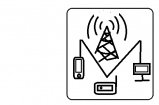OSI Model Bangla Tutorial(ওএস আই মডেল)
#Networking #OSI #Routing #Switching #Static #Dynamic #RIP #EIGRP #OSPF #BGP #NAT #ACL #CCNA #CCNP #CCIE #MCSA #RHCSA #RHCE #Nurunnabi
The Open Systems Interconnection model (OSI model) is a conceptual model that characterises and standardises the communication functions of a telecommunication or computing system without regard to its underlying internal structure and technology. Its goal is the interoperability of diverse communication systems with standard communication protocols.
The model partitions the flow of data in a communication system into seven abstraction layers, from the physical implementation of transmitting bits across a communications medium to the highest-level representation of data of a distributed application. Each intermediate layer serves a class of functionality to the layer above it and is served by the layer below it. Classes of functionality are realized in software by standardized communication protocols.
The OSI model was developed starting in the late 1970s to support the emergence of the diverse computer networking methods that were competing for application in the large national networking efforts in the world. In the 1980s, the model became a working product of the Open Systems Interconnection group at the International Organization for Standardization . While attempting to provide a comprehensive description of networking, the model failed to garner reliance by the software architects in the design of the early Internet, which is reflected in the less prescriptive Internet Protocol Suite, principally sponsored under the auspices of the Internet Engineering Task Force .
In the early- and mid-1970s, networking was largely either government-sponsored or vendor-developed with proprietary standards, such as IBM’s Systems Network Architecture and Digital Equipment Corporation’s DECnet. Public data networks were only just beginning to emerge, and these began to use the X.25 standard in the late 1970s.
The Experimental Packet Switched System in the UK circa 1973-5 identified the need for defining higher level protocols. The UK National Computing Centre publication ‘Why Distributed Computing’ which came from considerable research into future configurations for computer systems, resulted in the UK presenting the case for an international standards committee to cover this area at the ISO meeting in Sydney in March 1977.
Beginning in 1977, the International Organization for Standardization conducted a program to develop general standards and methods of networking. A similar process evolved at the International Telegraph and Telephone Consultative Committee (CCITT, from French: Comité Consultatif International Téléphonique et Télégraphique). Both bodies developed documents that defined similar networking models. The OSI model was first defined in raw form in Washington, DC in February 1978 by Hubert Zimmermann of France and the refined but still draft standard was published by the ISO in 1980.
The drafters of the reference model had to contend with many competing priorities and interests. The rate of technological change made it necessary to define standards that new systems could converge to rather than standardizing procedures after the fact; the reverse of the traditional approach to developing standards. Although not a standard itself, it was a framework in which future standards could be defined.
OSI had two major components, an abstract model of networking, called the Basic Reference Model or seven-layer model, and a set of specific protocols. The OSI reference model was a major advance in the standardisation of network concepts. It promoted the idea of a consistent model of protocol layers, defining interoperability between network devices and software.
The concept of a seven-layer model was provided by the work of Charles Bachman at Honeywell Information Systems.[8] Various aspects of OSI design evolved from experiences with the NPL network, ARPANET, CYCLADES, EIN, and the International Networking Working Group. In this model, a networking system was divided into layers. Within each layer, one or more entities implement its functionality. Each entity interacted directly only with the layer immediately beneath it and provided facilities for use by the layer above it.
OSI was an industry effort, attempting to get industry participants to agree on common network standards to provide multi-vendor interoperability. It was common for large networks to support multiple network protocol suites, with many devices unable to interoperate with other devices because of a lack of common protocols. For a period in the late 1980s and early 1990s, engineers, organizations and nations became polarized over the issue of which standard, the OSI model or the Internet protocol suite, would result in the best and most robust computer networks. However, while OSI developed its networking standards in the late 1980s, TCP/IP came into widespread use on multi-vendor networks for internetworking.
Views : 5109
model osi
Source by IT Solutions For Students




